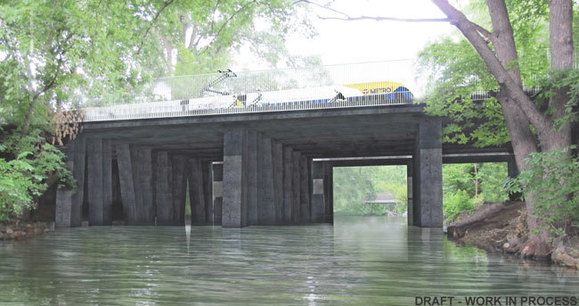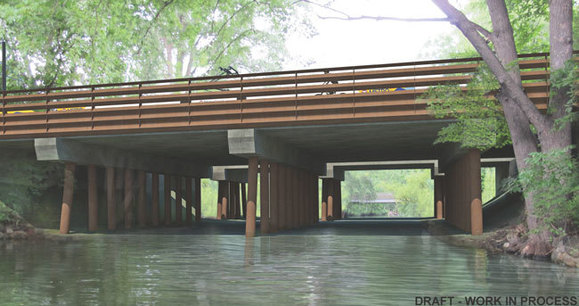|
ST.LOUIS PARK, Minn. – Nov. 24, 2014 –Three bridge concepts presented today for the Kenilworth channel crossing on the Southwest LRT (METRO Green Line Extension) would reinterpret the existing wooden railroad bridge with new low-profile structures.
The project designers’ concepts feature arches, angled piers and a thin deck reminiscent of the existing railroad bridge and are fashioned to fit in with the natural surroundings, as initially recommended by several parties. These parties include the Minnesota Department of Transportation, the State Historic Preservation Office, the Minneapolis Park and Recreation Board, the city of Minneapolis and Kenwood Isles Area Association. Structural engineers tested the concepts, and designers presented them today to these parties and staff of the five corridor cities and Hennepin County.
“These are not full-blown designs. They are just in the idea stage for discussion as part of our consultation process for historic properties,” said Jim Alexander, director of design and engineering for the Southwest LRT Project.
The consultation, a federal requirement, will continue throughout the design process in 2015 for the freight railroad bridge and the combined LRT/trail bridge over the channel between Cedar Lake and Lake of the Isles.
About the three concepts
The three bridge concepts are called arched pier, thin deck and steel pier.
To minimize the visual impact and hazards for channel users, all three bridge concepts would be supported from below only with just three rows of piers, down from the six on the existing wooden railroad bridge.
Poles holding the overhead wires that carry electricity to power the trains would not be located on the bridge. In the current concepts, they would be set substantially back from the banks of the channel.
 Existing wooden railroad bridge: The bridge has six rows of wooden piers. Each side has different types of railing. View is looking west with the Burnham Road Bridge in the background.
 Arched Pier Concept: Concrete arched piers would support a concrete deck with steel railings, recalling the essence of the existing rail bridges of the Chain of Lakes area. View is looking west with the Burnham Road Bridge in the background.
 Thin Deck Concept: canted (angled) concrete piers would support a thin deck of concrete with light steel railings. The thin deck lessens the visual impact of the bridge over the channel. The concept would use charcoal-tinted concrete to reinterpret the existing wooden railroad bridge. Both the arched pier and thin deck concepts would be made of cast-in-place concrete. View is looking west with the Burnham Road Bridge in the background.
 Steel Pier Concept: canted (angled) steel pier made of natural steel would support a concrete deck with natural steel railings that will weather in a couple of years to a warm brown patina. This concept would use natural steel to reinterpret the existing wooden railroad bridge. View is looking west with the Burnham Road Bridge in the background.
Cost estimates: Range from $4 million to $7 million. More detailed cost estimates will be completed as the designs are refined and finalized. This cost is already included in the project budget.
Next steps
Project staff will present the three bridge concepts at the Dec. 3 Southwest Corridor Management Committee meeting for feedback. Staff will seek public input in 2015.
About the project:
The planned Southwest Light Rail Transit (LRT) Project (METRO Green Line Extension) will operate from downtown Minneapolis through the communities of St. Louis Park, Hopkins, Minnetonka, and Eden Prairie, passing in close proximity to the city of Edina. The line will connect major activity centers in the region including downtown Minneapolis, the Opus/Golden Triangle employment area in Minnetonka and Eden Prairie, Methodist Hospital in St. Louis Park, downtown Hopkins, the Eden Prairie Center Mall, and the Minneapolis Chain of Lakes. Ridership in 2030 is projected at nearly 34,000 weekday boardings. The project will interline with the METRO Green Line, which will provide a one-seat ride to destinations such as the University of Minnesota, state Capitol and downtown St. Paul. It will be part of an integrated system of transitways, including connections to the METRO Blue Line, the proposed METRO Blue Line Extension, the Northstar Commuter Rail line, a variety of major bus routes along the alignment, and proposed future transitway and rail lines. The Metropolitan Council will be the grantee of federal funds. The regional government agency is charged with building the line in partnership with the Minnesota Department of Transportation. The Southwest Corridor Management Committee, which includes commissioners from Hennepin County and the mayors of Minneapolis, St. Louis Park, Edina, Hopkins, Minnetonka, and Eden Prairie provides advice and oversight. Funding is provided by the Federal Transit Administration, Counties Transit Improvement Board (CTIB), state of Minnesota and Hennepin County Regional Railroad Authority (HCRRA). The Southwest LRT Project website is www.swlrt.org
|